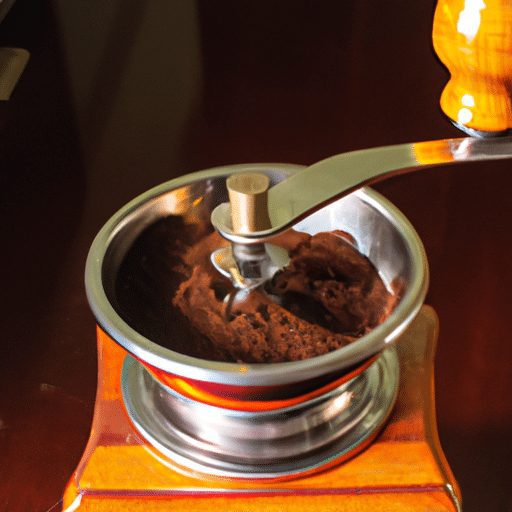Coffee lovers often find themselves wondering whether it is acceptable to use coffee grounds in their trusty grinder. The question of whether or not to put coffee grounds in a grinder is one that has baffled many caffeine enthusiasts. In this article, we will explore the truth behind this age-old dilemma and provide you with a clear answer to put your mind at ease. So, sit back, grab a cup of coffee, and delve into the world of coffee grounds and grinders with us.
Can I put coffee grounds in my grinder?
As coffee lovers, we are always striving to achieve the best possible flavor and aroma in our daily cup of joe. One question that often comes up is whether it is acceptable to put coffee grounds in a grinder. In this article, we will discuss why some people choose to put coffee grounds in their grinders, as well as the potential issues and drawbacks that may arise from this practice.
Why people put coffee grounds in their grinders
Desire for fresh ground coffee
One of the main reasons why individuals put coffee grounds in their grinders is to enjoy the unparalleled freshness that freshly ground coffee offers. By grinding the beans just before brewing, you can preserve the delicate flavors and aromas that are lost once coffee is exposed to air. This results in a more satisfying and flavorful cup of coffee.
Convenience
Another factor that drives people to put coffee grounds in their grinders is convenience. Having pre-ground coffee readily available in the grinder allows for quick and easy brewing, especially during those busy mornings when time is of the essence. It eliminates the need for a separate grinder and saves precious minutes in the coffee-making process.
Experimentation
Lastly, some coffee enthusiasts enjoy putting coffee grounds in their grinders as a way to experiment with different brewing methods and coffee varieties. By grinding different beans or adjusting the grind size, they can explore a whole range of flavors and find the perfect balance for their personal taste preferences.
Desire for fresh ground coffee
Enhanced flavor and aroma
Freshly ground coffee offers a distinct flavor profile that is simply unmatched by pre-ground coffee. The natural oils and volatile compounds in the beans are preserved, resulting in a more robust and aromatic brew. The process of grinding coffee releases these essential elements, allowing them to infuse into each cup and delight our senses.
Control over grind size
By grinding coffee beans ourselves, we have complete control over the size of the grounds. Different brewing methods, such as French press or espresso, require specific grind sizes for optimal extraction. With a grinder at our disposal, we can customize our grind to suit our preferred brewing method, ensuring a high-quality and well-balanced cup of coffee.
Preservation of coffee’s qualities
Coffee beans undergo a complex process of oxidation once they are ground, leading to a gradual degradation of flavor and aroma. By grinding coffee just before brewing, we can prevent this process from occurring prematurely. This preservation of the coffee’s qualities ensures that every cup we enjoy is as fresh and vibrant as possible.
Convenience
Efficiency in grinding process
Putting coffee grounds directly into the grinder eliminates an additional step of measuring and transferring the coffee beans. This streamlined process saves time and effort, allowing us to enjoy our cup of coffee more efficiently. It is particularly beneficial for those who have busy schedules and need a quick and hassle-free way to make their daily brew.
Saving time and effort
For many coffee lovers, convenience is key. By having pre-ground coffee in the grinder, we no longer need to measure out the beans and go through the process of grinding each time we want a cup of coffee. This time-saving approach can be a game-changer, especially during busy mornings or when entertaining guests.
Experimentation
Exploring different brewing methods
Putting coffee grounds in a grinder opens up a world of possibilities when it comes to experimenting with various brewing methods. Whether it’s pour-over, cold brew, or even using a coffee press, having the ability to adjust grind size and try different beans allows for endless exploration and discovery. This experimentation can lead us to find the perfect brewing method that suits our taste preferences and elevates our coffee experience.
Blending coffee varieties
By grinding our own coffee beans, we have the opportunity to blend different varieties and create unique flavor profiles. Whether it’s combining beans from different regions or experimenting with various roast levels, the ability to blend coffee allows us to tailor our cup of coffee to our exact preferences. It adds an element of creativity and personalization to our daily coffee routine.
Issues with putting coffee grounds in a grinder
While the convenience and experimentation aspects of putting coffee grounds in a grinder may seem enticing, there are several potential issues and drawbacks to consider before adopting this practice.
Damage to the grinder
One of the primary concerns with putting coffee grounds in a grinder is the potential damage it can cause to the machine itself. Coffee grounds are finer and denser than whole beans, which can put excessive strain on the grinder’s burrs and motor. Over time, this wear and tear can lead to reduced performance and a shorter lifespan for the grinder.
Inconsistent grind size
Another issue that may arise from putting coffee grounds in a grinder is the inconsistency of the resulting grind size. Unlike whole beans, which are more uniform in size, coffee grounds can vary in particle size, resulting in an uneven extraction. This can lead to under-extraction or over-extraction, resulting in a subpar cup of coffee with flavor imbalances.
Clogging the grinder
Coffee grounds often contain oils and residue that can accumulate in the grinder, leading to potential clogs and maintenance challenges. The build-up of coffee oils can hinder the grinder’s performance and affect its ability to grind consistently. Additionally, cleaning the grinder becomes more difficult when coffee grounds are involved, as they tend to stick to the machine’s internal components.
Damage to the grinder
Wear and tear on the burrs
Grinders are designed to handle whole coffee beans, not fine coffee grounds. The granules of coffee grounds can cause additional friction between the burrs, leading to accelerated wear and tear. This can result in a decrease in grinding efficiency and potential damage to the burrs over time.
Potential motor damage
The motor of a grinder is designed to handle the grinding process for whole coffee beans. When coffee grounds are put into the grinder, the motor may be subjected to excessive strain and overheating. Continuous use of coffee grounds in the grinder can potentially cause motor damage, leading to decreased performance or even complete failure.
Reduced lifespan
By regularly putting coffee grounds in a grinder, you may significantly shorten its lifespan. The additional wear and tear on the internal components, such as the burrs and motor, can lead to premature failure of the grinder. This can be a costly consequence, requiring repairs or even the purchase of a new grinder altogether.
Inconsistent grind size
Uneven extraction
Coffee extraction is a delicate process that relies on water passing through the coffee grounds at a consistent rate. When the grounds are not of uniform size, some particles may be over-extracted, resulting in a bitter taste, while others may be under-extracted, leading to a weak and watery brew. The inconsistent grind size caused by coffee grounds in a grinder can disrupt this extraction process, leading to an imbalanced and less enjoyable cup of coffee.
Poor quality coffee
Inconsistent grind size can directly impact the overall quality of the coffee. When some grounds are too coarse and others are too fine, it can result in over-extracted or under-extracted flavors. This leads to a loss of clarity and nuance in the taste, making the coffee less enjoyable and potentially disappointing.
Inadequate brew
The inconsistent grind size caused by coffee grounds in a grinder can also lead to inadequate brewing. Certain brewing methods, such as espresso, require a precise grind size to achieve the desired extraction. When the grind size is uneven, it can result in an imbalanced extraction, yielding a subpar espresso with a lack of crema or an overly bitter taste.
Clogging the grinder
Coffee oils and residue build-up
Coffee grounds contain oils and residue that can accumulate in the grinder, leading to clogs and performance issues. The fine particles of coffee grounds can stick to the internal components of the grinder, including the burrs and chute, creating a build-up that hinders the grinder’s functionality. This can result in slower grinding, uneven extraction, and an overall decrease in performance.
Difficult cleaning process
Cleaning a grinder that has clogged with coffee grounds can be a challenging and time-consuming task. The fine particles can be stubborn to remove, requiring thorough cleaning and disassembly of the grinder. This can be especially frustrating for those who value convenience and seek a hassle-free coffee-making experience.
Maintenance challenges
Regularly putting coffee grounds in a grinder can present ongoing maintenance challenges. The accumulation of coffee oils and residue in the internal components requires more frequent cleaning and upkeep to ensure the grinder’s longevity and optimal performance. This extra effort and attention may deter some individuals from adopting this practice.
In conclusion, while putting coffee grounds directly into a grinder may seem convenient and enticing at first, it is important to consider the potential issues and drawbacks that can arise. Damage to the grinder, inconsistent grind size, and clogging are all factors that must be taken into account. Ultimately, it is essential to weigh the convenience of using coffee grounds in a grinder against the potential compromise in the quality of your coffee and the lifespan of your grinder.





































